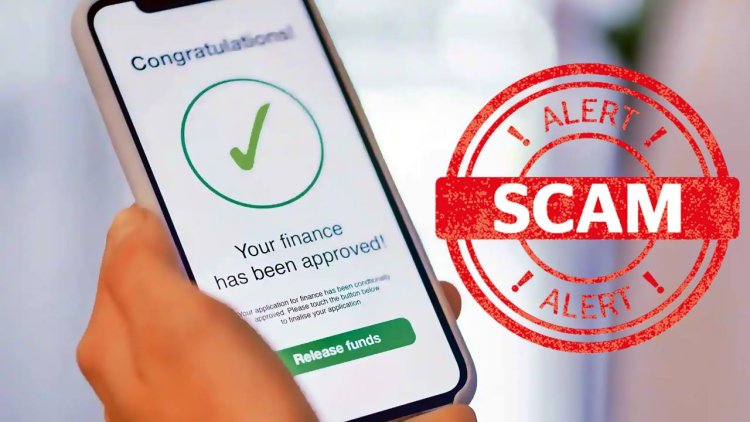The Rising Threat of Fake Loan App Fraud in India
The Dark Reality of Fake Loan Applications.

In recent years, India has witnessed a surge in the usage of digital platforms and mobile apps for various financial transactions and services. This digital revolution has brought convenience and accessibility to millions of Indians, making financial services more inclusive and efficient. However, this rapid growth in the digital finance sector has also given rise to a new breed of cybercriminals who exploit unsuspecting individuals through fake loan apps.
Fake loan app fraud is a growing menace that has affected countless individuals across the country. These fraudulent apps promise quick and easy loans but end up causing financial ruin, harassment, and the loss of personal information. In this blog, we will delve into the world of fake loan app fraud in India, exploring the modus operandi of these criminals, the consequences for victims, and the measures being taken to combat this issue.

Understanding Fake Loan App Fraud
Fake loan app fraud involves criminals creating and promoting mobile applications that masquerade as legitimate lending platforms. These apps often target vulnerable individuals who are in need of urgent financial assistance. The perpetrators typically advertise their apps through various means, such as social media, online advertisements, and spam emails, luring potential victims with promises of quick and hassle-free loans.
Once a user downloads and installs the fake loan app, they are asked to provide personal information, including their Aadhaar number, PAN card details, and bank account information. The criminals use this data for various nefarious purposes, including identity theft and further financial exploitation. The victims are then coerced into paying exorbitant processing fees, non-existent insurance charges, or even blackmail in some cases.

Modus Operandi of Fake Loan App Operators
Fake loan app operators employ various tactics to deceive their victims and extract money from them. Let's take a closer look at some of the common methods they use:
-
Impersonation: Many fake loan apps adopt names and branding that closely resemble legitimate financial institutions, making it difficult for users to distinguish between real and fake apps.
-
Aggressive Marketing: These fraudulent apps often flood social media and online platforms with enticing advertisements, promising instant loans without any background checks or documentation.
-
Data Harvesting: Once a user installs the app, it requests access to a wide range of personal information. This data is then misused for illegal activities.
-
Hidden Charges: Victims are led to believe they are receiving a loan, but they are required to pay upfront fees or charges for loan processing, insurance, or taxes. These fees can be exorbitant, and once paid, the promised loan never materializes.
-
Blackmail and Threats: Some criminals resort to blackmailing victims by threatening to expose their personal information, often obtained during the app installation process. This creates a sense of fear and compels the victim to pay additional sums of money.
Consequences for Victims
The victims of fake loan app fraud face a wide range of consequences, both financial and emotional. Some of the major issues faced by those who fall prey to these scams include:
-
Financial Loss: Victims lose money to the scammers, often paying excessive fees and charges without receiving any loan.
-
Personal Data Breach: Criminals gain access to personal information, leaving victims vulnerable to identity theft and further financial exploitation.
-
Credit Score Damage: The victims' credit scores may be negatively impacted as they unknowingly become involved in fraudulent activities.
-
Emotional Distress: The stress, anxiety, and fear resulting from falling victim to a fake loan app scam can take a significant toll on an individual's mental health.
-
Legal Complications: Some victims may find themselves entangled in legal disputes, especially if they took out loans in their name but didn't receive the funds.
The Extent of the Problem
Fake loan app fraud is a growing concern in India, with an increasing number of individuals falling victim to these scams. According to data from the Reserve Bank of India (RBI), there has been a significant rise in the number of complaints related to such fraudulent apps.
In 2021, the RBI cautioned the public against dealing with unauthorized digital lending platforms and asked users to verify the registration status of any lending app on their website. This warning came after numerous reports of harassment and exploitation by fake loan app operators.
The Indian government, as well as various state authorities, have been taking steps to combat this issue. Several arrests have been made in connection with fake loan app fraud, and regulatory bodies are working on implementing stricter guidelines to regulate digital lending platforms. However, the problem persists, and it is crucial for users to be cautious and aware of the risks.
The Role of Regulatory Bodies
The role of regulatory bodies in addressing the issue of fake loan apps is significant. These organizations work to create a safer and more secure digital lending environment. Some key initiatives and actions taken by regulatory bodies include:
-
Reserve Bank of India (RBI): The RBI has been actively working to regulate digital lending platforms and has issued guidelines for NBFCs (Non-Banking Financial Companies) operating in the digital lending space. They have also set up a helpline for users to report any suspicious activities.
-
Ministry of Electronics and Information Technology (MeitY): MeitY has taken measures to block fake loan apps, ensuring they are removed from app stores. They are also working on developing stricter regulations for app stores to prevent the listing of fraudulent apps.
-
State Governments: Several state governments, such as Telangana and Maharashtra, have initiated investigations and made arrests in cases related to fake loan app fraud. State authorities are also collaborating with central agencies to address the issue comprehensively.
-
App Stores: App stores like Google Play Store and Apple App Store are actively monitoring and removing fake loan apps to protect their users. They have implemented stricter guidelines for app developers to ensure that only legitimate lending platforms are available for download.

Preventive Measures for Users
To protect oneself from falling victim to fake loan app fraud, users can take the following preventive measures:
-
Verify the Lender: Always verify the credentials of the lending app and ensure it is registered with the RBI. Cross-check the app's authenticity on the RBI website.
-
Read Reviews and Ratings: Go through user reviews and ratings on app stores to gauge the legitimacy and user experience of the app.
-
Avoid Unrealistic Promises: Be cautious of apps that promise loans without any documentation, background checks, or credit history. Legitimate lenders follow due diligence processes.
-
Protect Personal Information: Do not share personal or sensitive information with apps that do not have a verified and trustworthy reputation.
-
Check for Hidden Charges: Read the terms and conditions carefully to understand any processing fees or charges associated with the loan. Be wary of apps that ask for payment upfront.
-
Report Suspicious Activity: If you come across a fake loan app or believe you have been scammed, report it to the RBI or local law enforcement agencies.
Conclusion
Fake loan app fraud is a pressing issue in India, with criminals exploiting the desperation and financial vulnerability of individuals in need of quick loans. The consequences of falling victim to these scams can be severe, leading to financial loss, personal data breaches, and emotional distress.
While regulatory bodies and the government are taking steps to combat fake loan app fraud, it is crucial for users to remain vigilant and exercise caution when considering digital lending platforms. By following preventive measures and staying informed about the risks associated with these apps, individuals can protect themselves from falling prey to this growing menace in the digital finance landscape.















